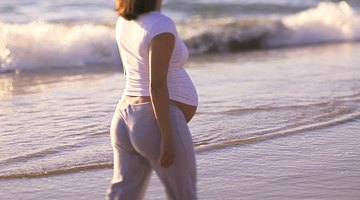Aches & Pains at 28 Weeks Pregnancy
The 28th week marks the beginning of the third trimester of pregnancy. Physical and emotional aches and pains are normal and common. As weight gain approaches its peak, women may find it difficult to get comfortable, even while lying down. They may worry about the upcoming birth or how their lives will change with the addition of a baby to the family. Sometimes these worries manifest themselves as aches in the joints and muscles. Women should keep their doctors or midwives abreast of any pregnancy-related aches or pains.
Physical Causes
Relaxin is the hormone responsible for loosening a pregnant woman’s joints and ligaments, and as the third trimester begins, it floods the system. This can contribute to a variety of pains, most commonly felt in the round ligament, which connects the uterus to the groin; the sciatic nerve, which starts in the lower back and runs through the hips and down the legs; and the sacroiliac join, which connects the sacrum to the ilium.
Emotional Causes

Abdominal Muscle Pain After Pregnancy
Learn More
Fears and anxieties typically surface at the beginning of the third trimester, as the pregnancy draws to a close. Famed midwife Ina May Gaskin talks about the connection between a jaw clenched in worry and tight, closed, painful hips. Many mothers may feel the urge to nest, or deep clean and prepare and freeze meals, at the beginning of the third trimester. This evolutionary response to labor can be a welcome burst of energy to some women, but they must be careful not to exhaust and injure themselves.
Nutrition
Midwife Ina May Gaskin outlines the importance of adequate calcium, magnesium, iron and vitamin B intake in the prevention of pregnancy-related aches and pains. Women should eat whole foods such as grains, legumes, fruits and vegetables and avoid processed foods, sugar, white flour and caffeine.
Exercise

Stretching & Stomach Pains in Pregnancy
Learn More
Prenatal yoga treats both physical and emotional pains of pregnancy. Deep, meditative breath calms the mind and the central nervous systems while certain poses stretch and soothe the muscles. Yoga Journal recommends child’s pose, head-to-knee pose and pigeon pose for round ligament pain, sciatica and sacroiliac joint pain. Walking and swimming are also safe ways to move and calm the body and mind. Women should check with their birth professional before embarking on a prenatal exercise program.
Warning
While premature labor is rare at only 28 weeks, it does happen. The American Congress of Obstetricians and Gynecologists advises women to seek help immediately if aches are accompanied by discharge, pelvic pressure and cramps that wrap from back to front, contractions that come and go at regular intervals, diarrhea or ruptured membranes. These are all signs of impending birth.
Related Articles
- Babycenter: Your pregnancy, 28 weeks
- “Spiritual Midwifery, Fourth Edition”; Ina May Gaskin; 2002











